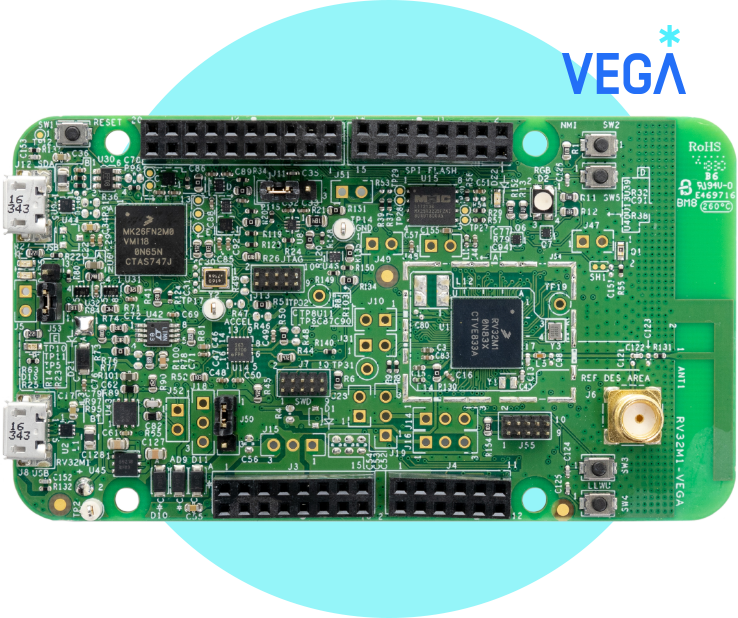RV32M1-VEGA

The RV32M1-VEGA development board.
The RV32M1 is a heterogeneous SoC including an ARM Cortex-M4 CPU, an ARM Cortex-M0+ CPU, a RISC-V RI5CY CPU, and a RISC-V ZERO_RISCY CPU. The SOC integrates 1.25 MB flash, 384 KB SRAM, and a variety of peripherals.
Refer to https://open-isa.org for further information about this board.
Note
Currently NuttX is ported to RV32M1 RI5CY only. RI5CY is RV32IMC RISC-V CPU with PULP extensions features:
Post-Incrementing load and stores,
Multiply-Accumulate extensions,
ALU extensions,
Hardware Loops.
Features
On-board OpenSDA Debug Adapter,
USB Device Port,
FXOS8700CQ Digital Combo Sensor: 3D Accelerometer + 3D Magnetometer,
Wirless Abilities: BLE, Generic FSK, and IEEE Std.802.15.4(Thread),
ONE user RGB LED,
Four user push-buttons,
4 MB external SPI Flash,
Micro-SD Card Slot on the backside,
Arduino R3 Compatible IO Header.
ITCM
A 64KB ITCM is coupled with M4 Cores, RI5CY CPU or ARM Cortex-M4 CPU. If the ITCM is selected, Critical Codes including but not limited to Exception Vectors, Interrupt Service Routines will be placed in ITCM.
TSTMR
TSTMR Module is embedded in RV32M1 to provide system time stamp. It runs off
1MHz with a 56-bit counter, and can be adopted to get more accurate delay
counting. If the module is selected, a hardware delay method will replace
up_mdelay and up_udelay, the built-in software delay methods.
Pin Mapping
LPUART Pins
LPUART0:
RX: PC7, PB25, PA2
TX: PC8, PB26, PA3
LPUART1:
RX: PB2, PC29, PA2, PA25
TX: PB3, PC30, PA3, PA26
LPUART2:
RX: PB11, PB18, PB1
TX: PB12, PB19, PB0
LPUART3:
RX: PB28, PE8, PE29
TX: PB29, PE9, PE30
LPUART0 is enabled in most configurations. RX and TX are configured on pins PC7 and PC8, respectively. These two above pins are connected to onboard Debug Adapter which provides a USB- TTL serial channel.
Installation
It is preferable to use OPEN ISA gcc Toolchain to exploit RV32M1 RI5CY capabilities, though the generic GNU RVG Toolchain can generate binary codes running on RV32M1 RI5CY without any problems. To switch generic GNU RVG Toolchain to OPEN ISA Toolchain, the following option must be selected in the Kconfig menu:
Board Selection --->
[*] Utilize OPEN ISA Toolchain
Make sure the OPEN ISA Toolchain has been installed and can be found in PATH.
Building NuttX
The RI5CY Core supports hardware loop with 6 hardware loop registers assistance,
these registers could be overwritten when contexts switch. If code is generated
by OPEN ISA Toolchain and CONFIG_ARCH_RISCV_INTXCPT_EXTREGS is not less than
6, the RI5CY specific architecture flag will be passed to the gcc compiler.
In that case, the 6 hardware loop registers must be saved and restored in
interrupt routines with the general purpose registers.
You will see the following lines in Make.defs file:
ARCHCPURV32IM = -march=rv32imc -mabi=ilp32
ifeq ($(CONFIG_RV32M1_OPENISA_TOOLCHAIN),y)
ifdef CONFIG_ARCH_RISCV_INTXCPT_EXTREGS
ifeq ($(filter 0 1 2 3 4 5 , $(CONFIG_ARCH_RISCV_INTXCPT_EXTREGS)),)
ARCHCPURV32IM = -march=rv32imcxpulpv2
endif
endif
endif
ARCHCPUFLAGS = $(ARCHCPURV32IM)
CONFIG_ARCH_RISV_INTXCPT_EXTREGS could be configured in the following menu:
System Type --->
[*] RISC-V Integer Context Extensions
(6) Number of Extral RISC-V Integer Context Registers
Flashing
To program the RV32M1, OpenOCD from OPEN ISA and an external JTAG adapter are prerequisites. There are 2 tested JTAG adapters:
Segger Jlink EDU mini
SiPEED USB JTAG Adapter
The Segger Jlink EDU mini can connect J55 header on RV32M1-VEGA board directly while SiPEED USB JTAG Adapter has to co-operate with an adapter board to setup wires connection. Compared to the Segger Jlink EDU Mini adapter, SiPEED USB JTAG Adapter is cheaper but not inferior.
With SiPEED USB Jtag Adapter, some patches must be applied to rv32m1_ri5cy.cfg:
--- a/rv32m1_ri5cy.cfg
+++ b/rv32m1_ri5cy.cfg
@@ -2,7 +2,11 @@ set _WORKAREASIZE 0x2000
adapter_khz 1000
-interface jlink
+interface ftdi
+ftdi_vid_pid 0x0403 0x6010
+ftdi_layout_init 0x0508 0x0f1b
+ftdi_layout_signal nTRST -data 0x0200 -noe 0x0100
+ftdi_layout_signal nSRST -data 0x0800 -noe 0x0400
transport select jtag
set _WORKAREASIZE 0x1000
Make sure that RV32M1 boots RI5CY, and you do this ONLY ONCE. Refer to RV32M1-VEGA quick start guide for more details.
Note
OPEN ISA Toolchain and rv32m1_ri5cy.cfg are contained in the RV32M1 SDK,
and the RV32M1-VEGA quick start guide can be found at the following link:
https://open-isa.org/downloads/
Warning
riscv64-unknown-elf-gdb can not debug RV32M1 RISC-V Cores currently. GDB
from the OPEN ISA Toolchain seems to be the only option and can even debug
ELF files generated by risc64-unknown-elf-* tools.
Configurations
You can configure NuttX using the following command:
$ ./tools/configure.sh rv32m1-vega:<config>
Where <config> is one of the configurations listed below.
All of the configurations can be compiled by the generic GNU RVG Toolchain and OPEN ISA Toolchain.
nsh
This configuration is basic. getprime is included in this configuration to
determine performance of RV32M1 RI5CY Core.
nsh-itcm
This configuration is a variant of the NSH configuration used for demonstrating
ITCM. When ITCM is selected, RI5CY Exception Vectors and Interrupt Service
Routines are placed in ITCM. Performance can be calculated by getprime, and
you might find it deteriorated a little ironically. The drawback may be caused
by long jump frequently between ITCM and flash. Besides, an instruction cache is
enabled always after RI5CY resets, and amelioration could not be achieved with
even ITCM enabled.
Todo
What if codes fulfill the 64KB ITCM ?